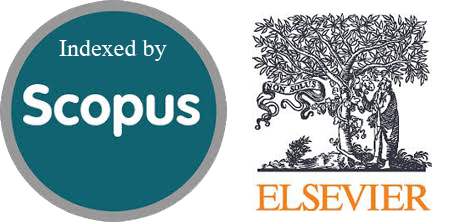Twitter Sentiment Analysis Towards Candidates of the 2024 Indonesian Presidential Election
Abstract
Long before the elections were held, the topic related to elections was widely discussed on news portals and social media, including Twitter. A few studies related to the Indonesian election have tried to predict candidates who will run for the presidential election, but there has been no research that examines public sentiment on social media towards each of the potential candidates. The main objective of this study is to analyze the public sentiment in Twitter towards potential candidates for the 2024 Indonesian presidential election. This research seeks to fill the gaps in previous research and become a reference for further research regarding sentiment analysis for election prediction using Twitter. The presidential candidates used in the research are the top 3 candidates based on the Poltracking survey, namely Ganjar Pranowo, Prabowo Subianto, and Anies Baswedan. The data were taken from January until October 2022, more than a year before the general election began. To predict the sentiment, four different machine-learning methods were used and compared to each other. There are Naïve Bayes, Support Vector Machines, Random Forests, and Neural Networks. Based on the sentiment results of each candidate, the highest sentiment towards Prabowo is neutral (55.49%), the highest sentiment towards Ganjar is positive (61.34%), and the highest sentiment towards Anies is neutral (44.84%). Results from the study also show that Anies was the presidential candidate who received more negative sentiment than the other two (56.63%). Meanwhile, Ganjar Pranowo got the most positive sentiment of all (42,69%). For the neutral sentiment, Anies Baswedan also got the most results (39,87%), followed by Prabowo (38.99%) and Ganjar Pranowo (21.14%). The result of the study also discovered that random forest and neural networks have the best performance for sentiment analysis.
Downloads
References
R. N. Catherine and D. Meiliana, “2024 Presidential Candidate Electability Survey, First Rank Followed by Prabowo and Anies Baswedan.” Accessed: Jun. 23, 2024. [Online]. Available: https://shorturl.at/Q1IJ4
R. Masud, M. Syamsurrijal, T. Baharuddin, and M. Azizurrohman, “Forecasting political parties and candidates for Indonesia’s presidential election in 2024 using twitter,” Int J Health Sci (Qassim), pp. 1323–1333, Jul. 2022, doi: 10.53730/IJHS.V6NS6.10691.
T. A. Arafat, I. Budi, R. Mahendra, and D. A. Salehah, “Demographic Analysis of Candidates Supporter in Twitter During Indonesian Presidential Election 2019,” in 2020 International Conference on ICT for Smart Society (ICISS), 2020, pp. 1–6. doi: 10.1109/ICISS50791.2020.9307598.
S. Limboi and L. Dioşan, “An unsupervised approach for Twitter Sentiment Analysis of USA 2020 Presidential Election,” in 2022 International Conference on INnovations in Intelligent SysTems and Applications (INISTA), 2022, pp. 1–6. doi: 10.1109/INISTA55318.2022.9894264.
R. Liu, X. Yao, C. Guo, and X. Wei, “Can We Forecast Presidential Election Using Twitter Data? An Integrative Modelling Approach,” Ann GIS, vol. 27, no. 1, pp. 43–56, Jan. 2021, doi: 10.1080/19475683.2020.1829704.
F. A. Wenando, R. Hayami, Bakaruddin, and A. Y. Novermahakim, “Tweet Sentiment Analysis for 2019 Indonesia Presidential Election Results using Various Classification Algorithms,” in 2020 1st International Conference on Information Technology, Advanced Mechanical and Electrical Engineering (ICITAMEE), 2020, pp. 279–282. doi: 10.1109/ICITAMEE50454.2020.9398513.
L. Wang and J. Q. Gan, “Prediction of the 2017 French Election Based on Twitter Data Analysis Using Term Weighting,” in 2018 10th Computer Science and Electronic Engineering (CEEC), 2018, pp. 231–235. doi: 10.1109/CEEC.2018.8674188.
M. Martínez-Rojas, M. del C. Pardo-Ferreira, and J. C. Rubio-Romero, “Twitter as a tool for the management and analysis of emergency situations: A systematic literature review,” Int J Inf Manage, vol. 43, pp. 196–208, Dec. 2018, doi: 10.1016/J.IJINFOMGT.2018.07.008.
Z. Drus and H. Khalid, “Sentiment analysis in social media and its application: Systematic literature review,” Procedia Comput Sci, vol. 161, pp. 707–714, 2019, doi: 10.1016/J.PROCS.2019.11.174.
S. Rodríguez et al., “Forecasting the Chilean electoral year: Using twitter to predict the presidential elections of 2017,” Lecture Notes in Computer Science (including subseries Lecture Notes in Artificial Intelligence and Lecture Notes in Bioinformatics), vol. 10914 LNCS, pp. 298–314, 2018, doi: 10.1007/978-3-319-91485-5_23.
W. Budiharto and M. Meiliana, “Prediction and analysis of Indonesia Presidential election from Twitter using sentiment analysis,” J Big Data, vol. 5, no. 1, 2018, doi: 10.1186/s40537-018-0164-1.
B. Bansal and S. Srivastava, “On predicting elections with hybrid topic based sentiment analysis of tweets,” Procedia Comput Sci, vol. 135, pp. 346–353, 2018, doi: https://doi.org/10.1016/j.procs.2018.08.183.
P. Singh, Y. K. Dwivedi, K. S. Kahlon, A. Pathania, and R. S. Sawhney, “Can twitter analytics predict election outcome? An insight from 2017 Punjab assembly elections,” Gov Inf Q, vol. 37, no. 2, 2020, doi: 10.1016/j.giq.2019.101444.
A. Singh, A. kumar, N. Dua, V. K. Mishra, D. Singh, and A. Agrawal, “Predicting Elections Results using Social Media Activity A Case Study: USA Presidential Election 2020,” in 2021 7th International Conference on Advanced Computing and Communication Systems (ICACCS), 2021, pp. 314–319. doi: 10.1109/ICACCS51430.2021.9441835.
T. Baharuddin, Z. Qodir, H. Jubba, and A. Nurmandi, “Prediction of Indonesian presidential candidates in 2024 using sentiment analysis and text search on Twitter,” International Journal of Communication and Society, vol. 4, no. 2, pp. 204–213, Jul. 2022, doi: 10.31763/ijcs.v4i2.512.
H. N. Chaudhry et al., “Sentiment Analysis of before and after Elections: Twitter Data of U.S. Election 2020,” Electronics 2021, Vol. 10, Page 2082, vol. 10, no. 17, p. 2082, Aug. 2021, doi: 10.3390/ELECTRONICS10172082.
H. N. Chaudhry et al., “Sentiment analysis of before and after elections: Twitter data of U.S. election 2020,” Electronics (Switzerland), vol. 10, no. 17, 2021, doi: 10.3390/electronics10172082.
B. J. Chellia, K. Srivastava, J. Panja, and R. Paul, “Sentiment analysis of twitter for election prediction,” Int J Eng Adv Technol, vol. 9, no. 1, pp. 6187–6192, 2019, doi: 10.35940/ijeat.A1767.109119.
M. Qorib, T. Oladunni, M. Denis, E. Ososanya, and P. Cotae, “Covid-19 vaccine hesitancy: Text mining, sentiment analysis and machine learning on COVID-19 vaccination Twitter dataset,” Expert Syst Appl, vol. 212, 2023, doi: 10.1016/j.eswa.2022.118715.
M. Bibi et al., “A novel unsupervised ensemble framework using concept-based linguistic methods and machine learning for twitter sentiment analysis,” Pattern Recognit Lett, vol. 158, pp. 80–86, Jun. 2022, doi: 10.1016/j.patrec.2022.04.004.
M. Luo and X. Mu, “Entity sentiment analysis in the news: A case study based on Negative Sentiment Smoothing Model (NSSM),” International Journal of Information Management Data Insights, vol. 2, no. 1, p. 100060, 2022, doi: https://doi.org/10.1016/j.jjimei.2022.100060.
K. Moilanen and S. Pulman, “Multi-entity Sentiment Scoring,” 2009. [Online]. Available: www.csie.ntu.edu.tw/
J. Ding, H. Sun, X. Wang, and X. Liu, “Entity-level sentiment analysis of issue comments,” in Proceedings - International Conference on Software Engineering, IEEE Computer Society, Jun. 2018, pp. 7–13. doi: 10.1145/3194932.3194935.
Copyright (c) 2024 Jurnal RESTI (Rekayasa Sistem dan Teknologi Informasi)

This work is licensed under a Creative Commons Attribution 4.0 International License.
Copyright in each article belongs to the author
- The author acknowledges that the RESTI Journal (System Engineering and Information Technology) is the first publisher to publish with a license Creative Commons Attribution 4.0 International License.
- Authors can enter writing separately, arrange the non-exclusive distribution of manuscripts that have been published in this journal into other versions (eg sent to the author's institutional repository, publication in a book, etc.), by acknowledging that the manuscript has been published for the first time in the RESTI (Rekayasa Sistem dan Teknologi Informasi) journal ;








